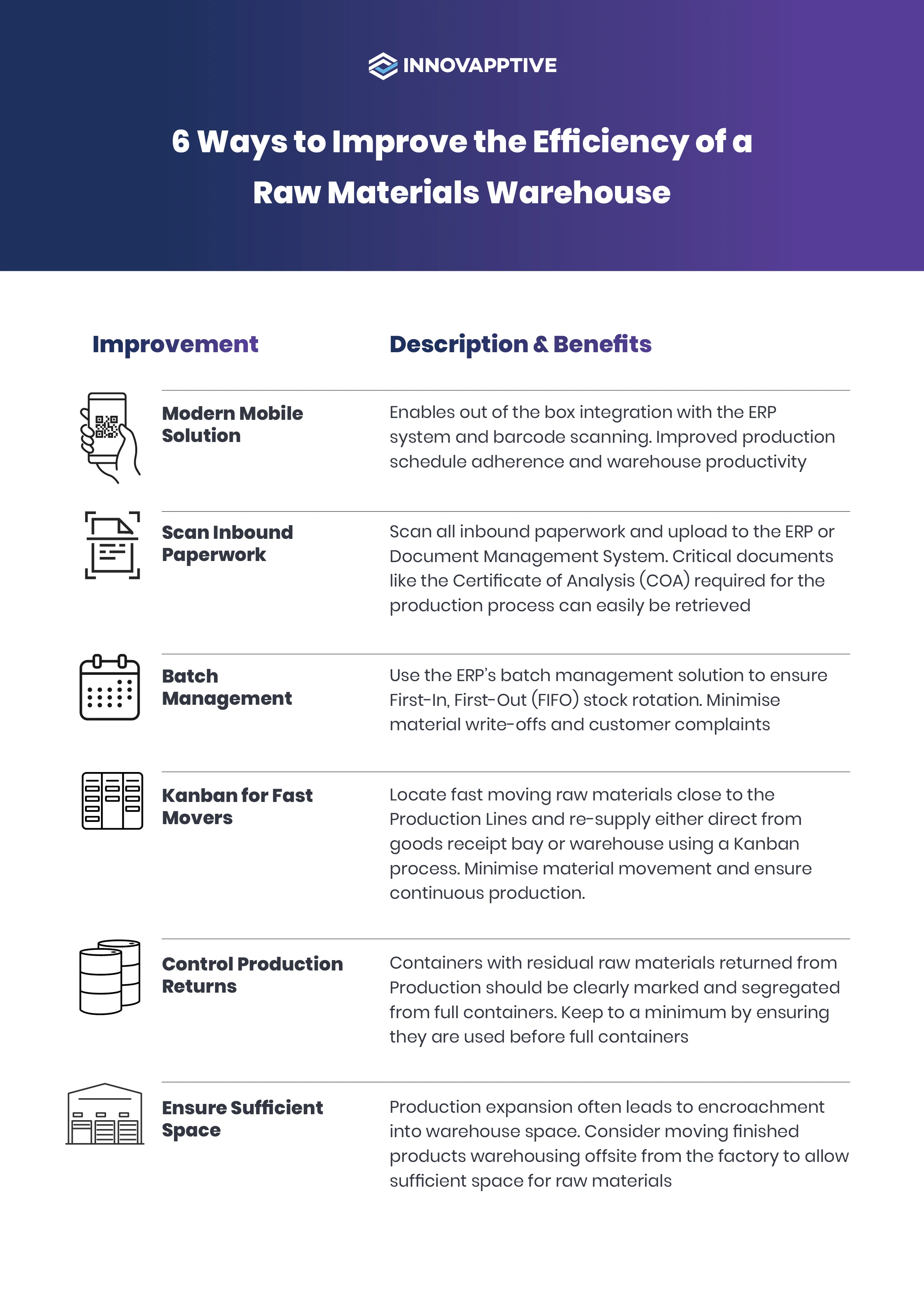Six Ways a Mobile Warehouse Solution Improves Raw Materials Storage Efficiency

Raw materials warehouses play a critical role in the supply chain, holding inventory in or close to factories, to ensure production lines continue to run. But they get less attention than their flashier neighbours, the finished good warehouse. Finished goods warehouses look smart with rows of uniform products neatly stacked on pallets. In contrast, the raw material warehouse is often a random array of boxes, drums, IBCs, and packaging from different suppliers. Finished goods are that much closer on their journey to the customer and the warehouse always seems to get more attention and investment!
It’s time to shine the spotlight on the raw material warehouse. The diagram below shows six ways to improve the efficiency of a raw materials warehouse.

Here are six improvement opportunities that can help to boost the efficiency of your raw material warehouse:
Modern Mobile Solution – If your raw materials warehouse still depends on paper-based processes, then inventory accuracy and productivity will take a hit. Modern mobile solutions offer out-of-the-box integration with ERP systems and barcode scanning to automate data capture and speed up business processes. Warehouse operators don’t need to return to the office to process transactions, enabling real-time inventory management and visibility. If suppliers are not able to put barcodes on materials that can be read by your ERP system, then they can print barcodes at goods receipt and apply them to materials to automate data capture across warehouse processes. Innovapptive’s mInventory provides over 90 out-of-the-box SAP inventory transactions and can be operated on IOS or Android smartphones, tablets, industrial scanners, and mobile or desktop printers. Our customers typically enjoy a 30 percent improvement in warehouse productivity when they move from paper-based processes to mInventory. Barcodes and scanning increases inventory accuracy are critical to ensure the warehouse can supply the correct raw materials to production.
Scan All Inbound Paperwork - Inbound warehouse processes are a vital link with suppliers and are often characterised by a heap of paper documents, such as Delivery Notes, Packing Slips, Bills of Ladings, Certificates of Analysis, etc. Many companies use a three-way match process between Purchase Orders, Goods Receipts, and Invoices to ensure that suppliers get paid the right amount for the quantity delivered. Any mismatch between the three documents can involve wasted time finding the original paper documents, investigating discrepancies, payment delays, and at worst, a breakdown in the relationship with suppliers. A modern mobile device enables easy document scanning using the smartphone’s camera. The digital document can then be uploaded into the ERP or Document Management System (DMS). The uploaded document is easily available across the organisation, meaning disputes can be quickly resolved. There's no longer a need to store space-wasting paper documents in the warehouse as every document now has an online digital version.
Batch Management - It's critical to ensure that raw materials are effectively controlled in the warehouse, especially if they are to be an ingredient in a finished product. A raw material past its shelf life can contaminate the finished product, causing expensive reworks, write-offs, or unhappy customers. Raw material warehouse processes, therefore, should be able to support First-In, First-Out (FIFO) stock rotation to ensure that older materials are used first and that the correct batch of material is picked for production. ERP systems have Batch Management capability, which ensures that all warehouse processes, e.g., material receipt, putaway, and picking are controlled at the material/batch level. Batch Management in the ERP system should be turned on for any product with a defined shelf-life. Batch management does add more complexity to warehouse operations and requires more space as each batch of the same material needs to be stored separately. Staff must be properly trained on the importance of control at the batch level.
Kanban for Fast Moving Materials – One of the foundation principles of warehouse design is to minimise distance travelled and unnecessary double handling of materials. Fast-moving materials should be stored in the most accessible part of the warehouse to reduce travel. One opportunity for raw materials is rather than storing them in the main warehouse, to move them directly from the goods receipt dock to a location adjacent to the production lines. Fast movers often include packaging material delivered to the factory on a just-in-time basis. The inventory of packaging next to the production line can be controlled using a Kanban process and, when inventory levels drop below a certain level, they can be replenished directly from the goods receipt bay. Minimising distance travelled is one of the easiest ways to increase warehouse productivity.
Control Production Returns – It's common that not all raw materials issued to production are used in the process. For example, a 55-gallon drum is issued to production, but only 35 gallons were required for the production process. Therefore, there are 20 gallons of residual material left in the drum. The partially used drum is returned to the warehouse, as the residual material can be used later. Ideally, this should be used on the next production run. But, in many operations, containers with residual materials are not well controlled. This can lead to a build-up of these containers and write-offs if materials are not used in time. Several simple processes can be deployed to overcome these challenges:
- Print a specific barcode label when the material is returned from production. This would indicate the material code, description, batch details, and quantity left in the container. Ensure these details are captured in the ERP system.
- Locate in the correct physical bin for that material. The ERP system is configured to ensure residual material is prioritised for picking on the next production run.
Ensure Sufficient Space – It’s not uncommon to see space-constrained operations. As product demand increases, companies need more production capacity and space for raw materials and finished goods warehousing. It's easier to move material storage than production lines, so companies end up with offsite overflow warehousing for raw materials, finished goods, or both. In our experience, if there is a choice to move raw materials or finished goods offsite, then it is better to move finished goods. These products are generally easier to handle (full pallet quantities) and move directly from the offsite warehouse to the customer. Raw materials come in a variety of pack sizes - they are not always used in full quantities and may require more specialist storage, e.g., dangerous goods. Raw materials may be required quickly to meet changes in the production plan and, therefore, it makes sense to co-locate them with production.
These six improvement opportunities have the power to transform raw material warehouses, improve productivity and ensure great service is provided to production. It’s time the raw material warehouse got some attention!
Learn more about how to improve the efficiency of your raw material warehouse.
Innovapptive, a connected worker pioneer, specializes in mobile warehouse management solutions. Watch a two-minute overview on mInventory here, then request a free demo here. Or, if you prefer, call one of our industry experts at 888-464-6668 to learn more. They’re ready to answer your questions, listen to your needs, and configure a solution to overcome your raw material warehouse challenges.

See It In Action
Schedule a personalized demo to see how our solutions can help your business thrive.
- 29-09-2025
Your Ultimate Guide to Connected Worker
In the rapidly evolving industrial landscape, maximizing plant efficiency and ensuring optimal...
- 20-08-2025
Building the future of Industrial Operations with Innovapptive and AWS
Most manufacturers have already gone digital. Yet business outcomes haven’t moved in step. Many...
- 22-04-2025
The $3.6B Unlock: Solving the Chemical Industry’s Labor Crisis and EBITDA Pressure in One Move
“Constraints don’t slow innovation—they force it.”


